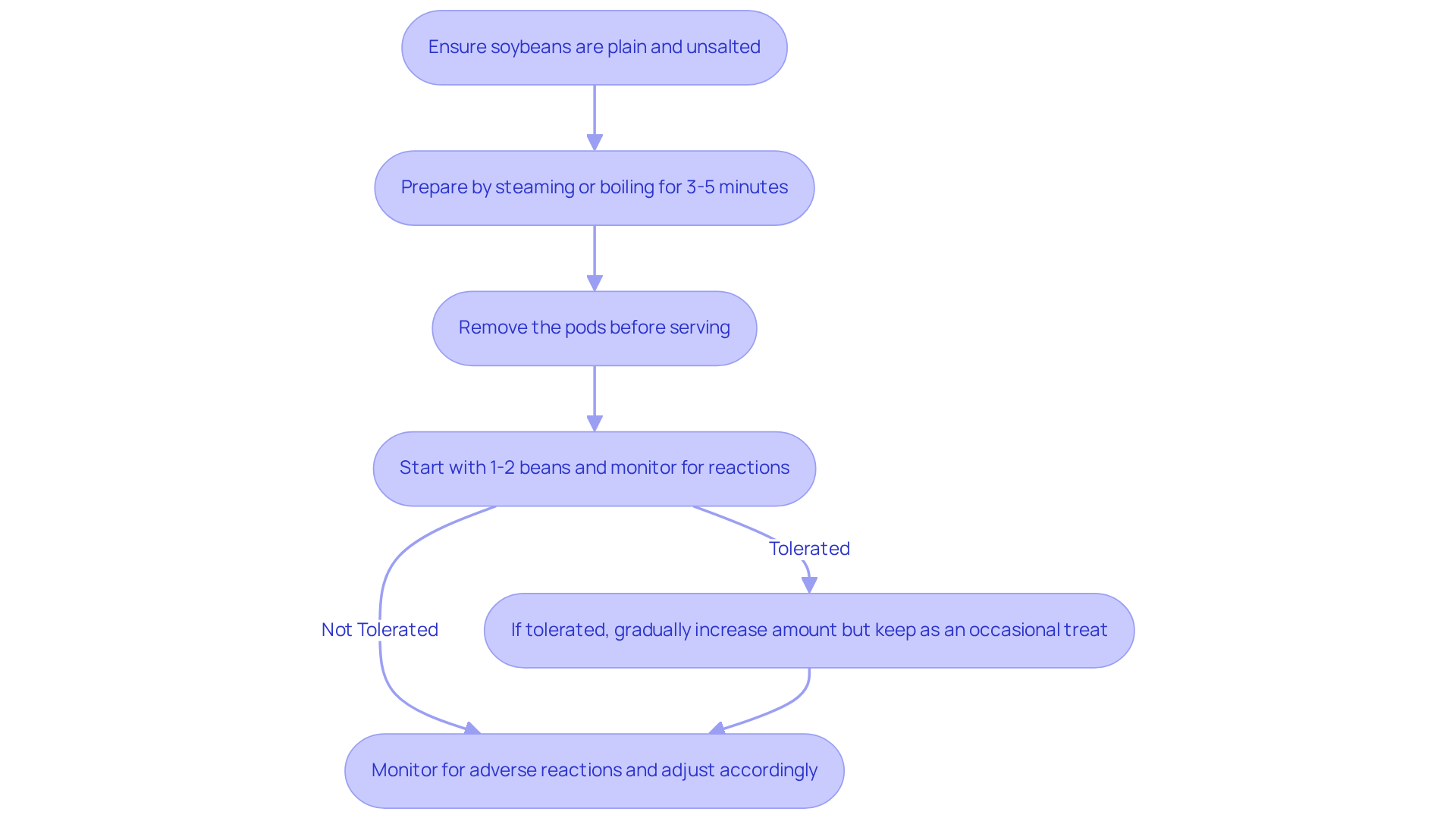Can Dogs Have Edamame? Understanding Its Benefits and Risks
Overview
As a loving pet owner, you may wonder about the best treats for your furry family members. Did you know that dogs can enjoy edamame in moderation? This delightful snack offers health benefits such as protein and fiber, both of which support muscle development and digestion. However, it’s essential to serve edamame plain and in small amounts to avoid any digestive issues or potential allergic reactions.
At Adventure Den, we understand how important it is to introduce new foods carefully. By doing so, you can ensure your pet’s well-being and happiness. Remember, a little goes a long way! Your pet deserves the best, and with a nurturing approach, you can make informed decisions about their diet. Always keep their health in mind, and your furry friends will thrive!
Introduction
Edamame, those tender young soybeans often savored in East Asian cuisine, are not just a delicious snack for humans; they may also offer nutritional benefits for your furry family members. Packed with protein, fiber, and essential vitamins, these little green gems can be a healthy addition to a canine diet when served correctly.
However, as a caring pet owner, you might wonder: can dogs safely enjoy edamame without risking digestive upset or allergic reactions? Understanding the balance between the benefits and potential risks is vital for ensuring that our beloved companions thrive on a varied diet.
At Adventure Den, we believe that nurturing your pet’s health is a priority, and exploring new food options can be part of that journey.
Define Edamame: What It Is and Its Nutritional Profile
Edamame, those delightful immature soybeans harvested before ripening, are often enjoyed boiled or steamed and hold a cherished place in East Asian cuisines. This nutrient-dense food is a treasure trove of protein, fiber, and essential vitamins like C and K, along with vital minerals such as iron and calcium. Just imagine, a cup of shelled soybeans contains around 188 calories, 18.4 grams of protein, and 8 grams of fiber—making it a wonderful snack option for both you and your furry family members, particularly when you consider if can dogs have edamame.
Moreover, you may wonder if can dogs have edamame, as these young soybeans are rich in beneficial omega-6 and omega-3 fatty acids, supporting heart health for your beloved pets. Given their low glycemic index, the question of can dogs have edamame arises, as they are suitable for canines, including those managing diabetes, helping them feel full without piling on the calories. However, it’s important to serve soybeans in moderation; too much can lead to digestive discomfort, such as stomach cramps, gas, and bloating. Remember to discard the pods, as they are not edible.
Overall, incorporating soybeans into your pet’s diet can be a healthy choice, offering various nutritional advantages, including being a complete protein source—a crucial consideration for pet owners seeking nutritious options for their animals, especially when wondering if can dogs have edamame. Additionally, the phytoestrogen content in soybeans may have implications for hormonal health, so it’s wise to reflect on these factors when thoughtfully including them in your pets’ meals. Your commitment to their well-being is what truly matters, and every small step counts towards nurturing a healthier, happier life for your pets.

Assess Edamame for Dogs: Health Risks and Benefits
When considering if can dogs have edamame, it’s important to note that it can offer a variety of health benefits for your furry family members when given in moderation. This nutritious snack is rich in protein, with a 100g serving containing 11g of protein, which is vital for muscle development and overall health. Additionally, the significant fiber content aids digestion and helps regulate bowel movements, contributing to your pet’s well-being.
However, it’s important to be aware of potential risks associated with the question of whether can dogs have edamame. Some canines may develop allergies to soy, leading to symptoms like itching, gastrointestinal upset, or even more severe reactions. While soy makes up merely 6% of all canine adverse reactions to nutrition, it’s essential to recognize that soy allergies can occur, even if they are not prevalent.
Moreover, the high fiber content in these soybeans can lead to gas or bloating if consumed in excessive amounts. Therefore, introducing soybeans gradually into your dog’s diet is crucial. New foods should be added slowly to monitor your pet’s reactions. As a general guideline, it’s safe to provide your dog up to 1 tablespoon of soybeans for every 10 pounds your pup weighs, no more than once or twice per week.
Additionally, soybeans are low in fat and calories, making them a healthy snack choice. Just remember to serve them plain and in small quantities to prevent any digestive issues. You can easily find edamame beans in most grocery stores, typically located in the frozen food aisle, and many pet owners wonder, can dogs have edamame as an accessible treat? By considering these factors, you can create a nurturing environment for your beloved pet while introducing them to new and healthy snacks.

Introduce Edamame Safely: Guidelines for Pet Owners
To safely introduce this soybean snack to your furry family member, please follow these caring guidelines:
- Ensure the soybeans are plain and unsalted, as added seasonings can be harmful.
- Prepare the soybeans by steaming or boiling them for about 3-5 minutes to soften the beans, making them easier to digest.
- Remember to remove the pods before serving, as they can pose a choking hazard.
- Start with just a small amount, such as 1-2 beans, and watch for any signs of allergies or digestive upset.
- If your dog tolerates edamame well, you might wonder, can dogs have edamame, and if so, you can gradually increase the amount, but it should remain an occasional treat rather than a regular part of their diet.
Did you know that there has been an 18% rise in sales of functional pet treats? This indicates that pet owners are becoming more aware of their beloved animals’ nutritional needs. Additionally, with 56% of dogs classified as clinically overweight or obese, it’s crucial to introduce new foods cautiously and ensure they align with your pet’s specific health needs.
Expert recommendations suggest that any dietary changes should be made with care, always monitoring your pet for any adverse reactions. By taking these steps, you can help create a nurturing environment for your pet while ensuring their health and happiness.

Conclusion
Incorporating edamame into your dog’s diet can be a beneficial choice when approached with care and moderation. This nutrient-rich snack not only provides essential protein and fiber but also supports overall health, making it an appealing option for pet owners eager to enhance their furry family members’ nutrition. However, it is crucial to consider potential risks, including allergies and digestive issues, to ensure that this treat remains a safe addition to their diet.
The nutritional profile of edamame is impressive, with high protein content and beneficial fatty acids. It’s important to introduce it gradually, allowing you to monitor for any adverse reactions. Key guidelines for serving edamame safely to dogs include:
- Ensuring the beans are plain
- Removing the pods
- Starting with small portions
These steps are vital in creating a positive experience for both pets and their caregivers.
Ultimately, the decision to share edamame with your dog should be made thoughtfully, balancing the potential health benefits with the risks. By remaining vigilant and informed, you can confidently explore new dietary options for your beloved pet, contributing to their long-term health and happiness. Embracing such nutritious treats can lead to a more enriched and fulfilling life for dogs, reinforcing the special bond between pets and their families.
Frequently Asked Questions
What is edamame?
Edamame refers to immature soybeans that are harvested before ripening, typically enjoyed boiled or steamed, and are a staple in East Asian cuisines.
What is the nutritional profile of edamame?
Edamame is nutrient-dense, containing around 188 calories, 18.4 grams of protein, and 8 grams of fiber per cup. It is also rich in vitamins C and K, as well as essential minerals like iron and calcium.
Can dogs have edamame?
Yes, dogs can have edamame in moderation. The young soybeans are rich in beneficial omega-6 and omega-3 fatty acids, which can support heart health for pets.
Are there any precautions when feeding edamame to dogs?
Yes, it is important to serve edamame in moderation to avoid digestive discomfort such as stomach cramps, gas, and bloating. Additionally, the pods should be discarded as they are not edible.
What are the benefits of including edamame in a dog’s diet?
Incorporating edamame into a dog’s diet can provide nutritional advantages, as it is a complete protein source and has a low glycemic index, making it suitable for dogs managing diabetes.
What should pet owners consider when feeding edamame to their pets?
Pet owners should consider the phytoestrogen content in soybeans, which may have implications for hormonal health, and reflect on these factors when including edamame in their pets’ meals.







